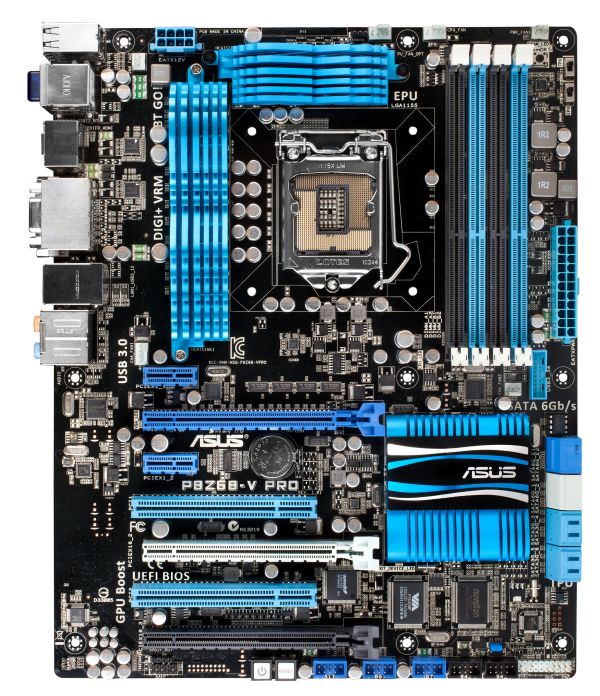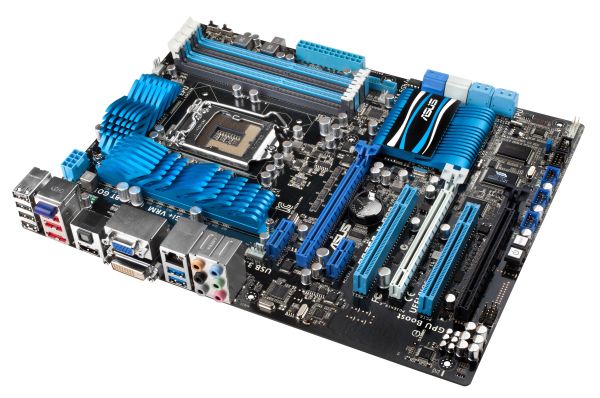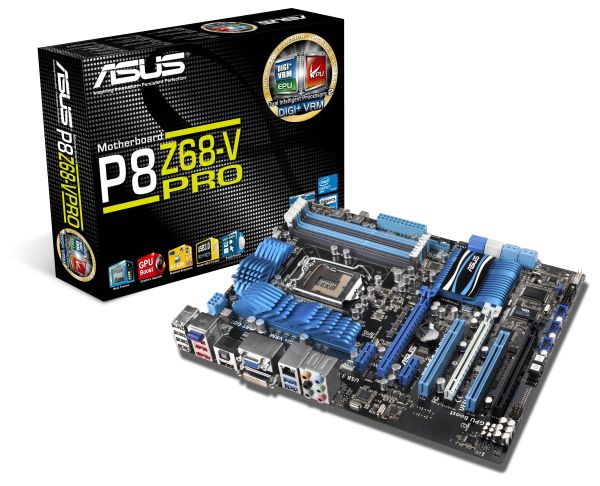ASUS P8Z68-V PRO Review: Our First Z68 Motherboard
by Ian Cutress on May 11, 2011 3:13 AM EST- Posted in
- Motherboards
- Asus
- Z68
ASUS P8Z68-V PRO: Overview
This board from ASUS is a great all-round performer, compared to the P67 boards we have reviewed—space for tri-GPU setups, six fan headers with good OS fan controls, eight SATA ports, six with RAID 0/1/5/10, Intel gigabit Ethernet and it performs well in our benchmark suite. The goods bundled in the box aren't the best we've seen, especially for an expected retail price of $210. But this is a Z68 board—the seemingly logical progression Intel have taken to combine the best bits of P67 and H67, in terms of overclocking. It's thanks to software solutions such as LUCIDLOGIX's Virtu that we can harness both the integrated GPU and discrete GPUs for different work loads—I detail my experiences with Virtu in this review.
ASUS P8Z68-V PRO: Visual Inspection
A quick look at the P8Z67-V PRO board and you might be joining me in thinking it looks almost identical to the P8P67 PRO motherboard. The blue, black and grey livery is still here, with those blue wavy heatsinks covering up the 12 phase CPU and 4 phase iGPU power delivery—unlike other boards, these aren't joined by a heatpipe, and the larger heatsink has a pretty substantial plate connecting the ends on the back of the board.
Around the socket itself, there is one 4-pin chassis fan header near the PCIe 1x, one PWR 3-pin near the 12V CPU power connector, and two CPU fan headers (one 4-pin, one 3-pin) to the top right, which should cover any all-in-one cooling solution with a dual fan and water pump arrangement. Unlike some other Cougar Point motherboards, ASUS have located the PCH to below the DIMM slots, under a large flat heatsink which gets quite warm to touch under normal operation.
Alongside the DIMM slots we have another 3-pin PWR fan header in the top right, just above ASUS' EPU and TPU switches, which activate their Energy Processing Unit and TurboV Processing Units respectively, for lower power usage or automatic overclocking. Enabling both could lead to system instability, however. Underneath these, beyond the 24-pin ATX power connector is a a 3-pin chassis fan header and the USB 3.0 19-pin header. As this is placed here, you would assume ASUS are thinking everyone will be using this header to power a USB 3.0 bracket in the front of the case, rather than the rear. But the supplied USB 3.0 bracket is designed for the rear of the board and doesn't stretch that far, especially over a dual slot GPU should one be in use.
The SATA ports are similar to that found on the P8P67 Pro—the four SATA 3 Gbps from the PCH are in blue, the two SATA 6 Gbps from the PCH are in white, and two SATA 6 Gbps from a Marvell controller. Rather than place the Power/Reset buttons underneath the SATA ports, they are found amongst the myriad of USB and IEEE 1394 headers along the bottom of the board, making them very inconvenient if all three full-size PCIe slots are occupied with dual slot cards.
The PCIe slot arrangement is standard—enough space at the top for a full length PCIe x1 card, with a PCIe x16 slot underneath with a triple slot gap to the next PCIe x16. The three full length PCIe slots run in x16/x0/x4 or x8/x8/x4 mode for GPU setups. However, the bottom PCIe slot shares bandwidth PCIe x1 slots, a two USB ports in the IO panel and the eSATA IO port—all of these are inactive if the bottom PCIe is in x4 mode. By default, the PCIe is in x1 mode, and requires a BIOS setting change for x4.
The IO panel for Z68 boards supporting integrated graphics is a combined mix of previous P67 and H67 iterations, and as such we either lose legacy connections or USB ports infavor of video out ports. There's no PS/2 legacy connector—instead we have on the far left four USB 2.0 ports, then another two USB 2.0 ports, the eSATA 3 Gbps port powered by a JMicron JMB362 controller, and a Bluetooth module. These red USB 2.0 ports/eSATA port are the ones disabled when the third PCIe is in x4 mode. In terms of video outputs, we have a HDMI, DVI and VGA—no display port here, instead you get an optical S/PDIF out (which also means no coaxial S/PDIF out). Just a single gigabit Ethernet port powered by an Intel 82579, and a pair of USB 3.0 ports powered by ASMedia controller. Standard Realtek ALC892 8-channel audio is also present.














95 Comments
View All Comments
fr500 - Thursday, May 12, 2011 - link
Not any new crashes but there are crashes now and them with certain nvidia driver versions on TF2 for instance. With an aditional layer on top it makes it worse I guess...Also I said that about control panels because of techreport's review but it seems they didn't know about d mode
AnnihilatorX - Thursday, May 12, 2011 - link
Anand noted that Intel said (when virtu didn't exist), to use QuickSync in Z68, one needs to use 2 monitors.So basically you can have 2 separate monitors, one connection from discrete and one from onboard.
L. - Thursday, May 12, 2011 - link
I'm pretty sure you can come up with more complex and useless examples of using relatively bad technology, namely Lucid.As long as you have a real gpu, you should not be using the IGP at all, that is not going to change anytime soon as 7% of a real GPU >>> anything Intel ever made.
Not to worry though, Virtu will be gone very soon, like Hydra.
"Normally", you should be able to send the transcoding to your GPU and have 3d / screen input at the same time.
In other words : intel IGP bad except if you don't have anything else, virtu bad always unless your GPU is really bad too (wtf?).
This will become more interesting when AMD starts selling Llano, as llano's gpu will be much stronger than Intel's IGP and using both ressources efficiently (discrete+igp) will make a real difference.
fr500 - Thursday, May 12, 2011 - link
The whole deal with this is QuickSync is really fast for transcoding.I don't like the idea of Hydra either so I think using a spare input from your monitor could work, it would still be detected even if the input is not the current active one and even if it doesn't get detected you could just select the other input, do your transcoding and be done with it.
cbgoding - Wednesday, May 11, 2011 - link
So 1.42V was your safe limit, but under load it jumped to 1.544 V?What the hell?
AnnihilatorX - Thursday, May 12, 2011 - link
He wrote 'but'. He's suggesting a bug in the TurboV softwarecbgoding - Friday, May 13, 2011 - link
alright, makes sense. Guess I'll never use TurboV, I'd shit a brick if i had a .124V spike.L. - Thursday, May 12, 2011 - link
My mobo does that ... although I went a bit hard on the pencilmod on purpose - which gives me a vload > vidle (although very close, it's about .025 more).DBissett - Thursday, May 12, 2011 - link
Sorry for grammar policing but some grammar is so bad it makes reading otherwise good articles impossible. "Asus" and "Intel" are companies, singular nouns, and require singular verbs. To say "Asus have" and "Intel have" is not only technical incorrect but just plain reads very badly. "Asus has...." and "Intel has...." is the correct grammatical form. Or if you have to use plural verbs then try "People at Asus have..." for example, and now you've got a plural subject.Dave
IanCutress - Friday, May 13, 2011 - link
Hi Dave,This is one of the (many) differences between British and American English. I attempt to write in an American style for AnandTech, but as I am British, a few things scrape through the net.
All the best,
Ian